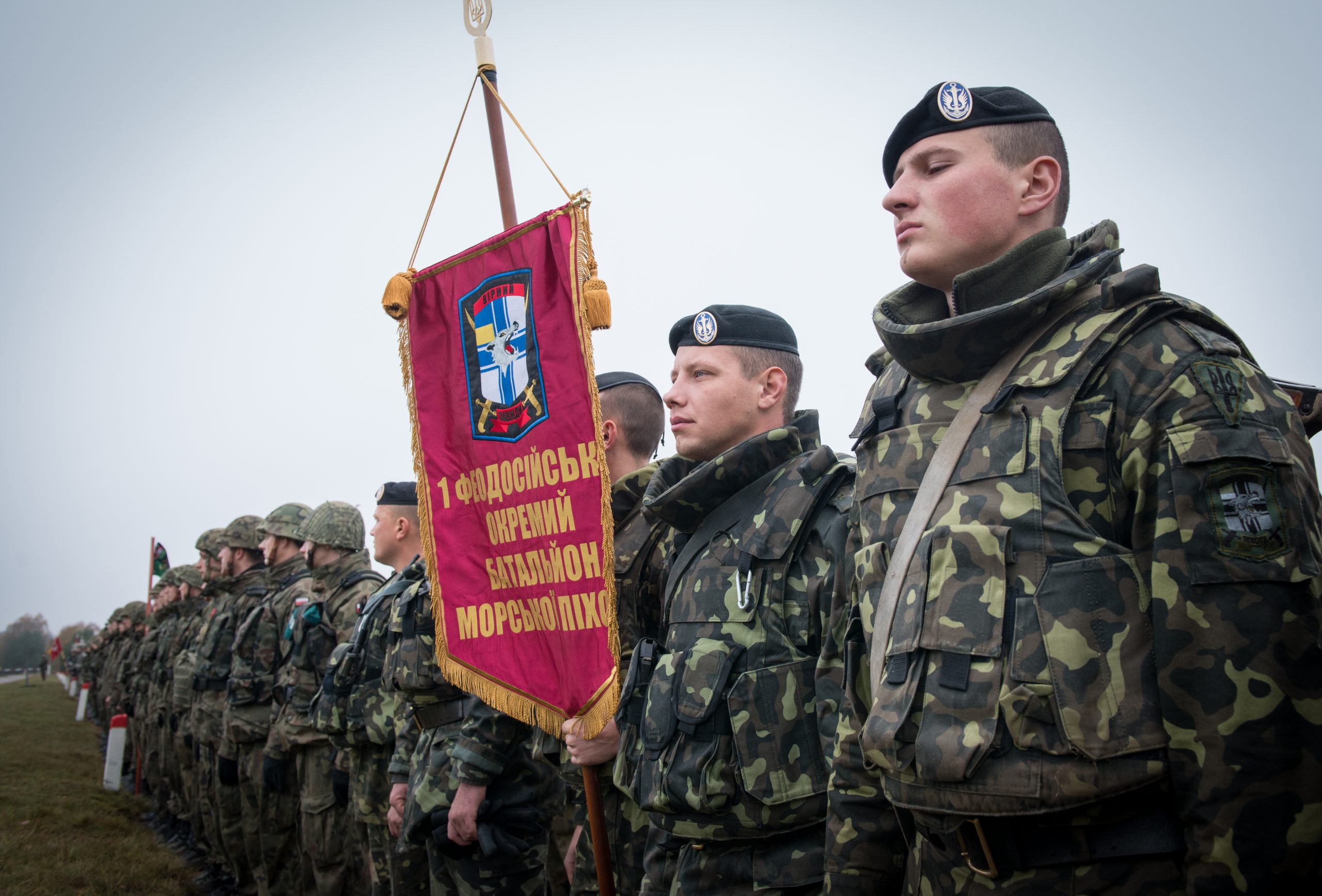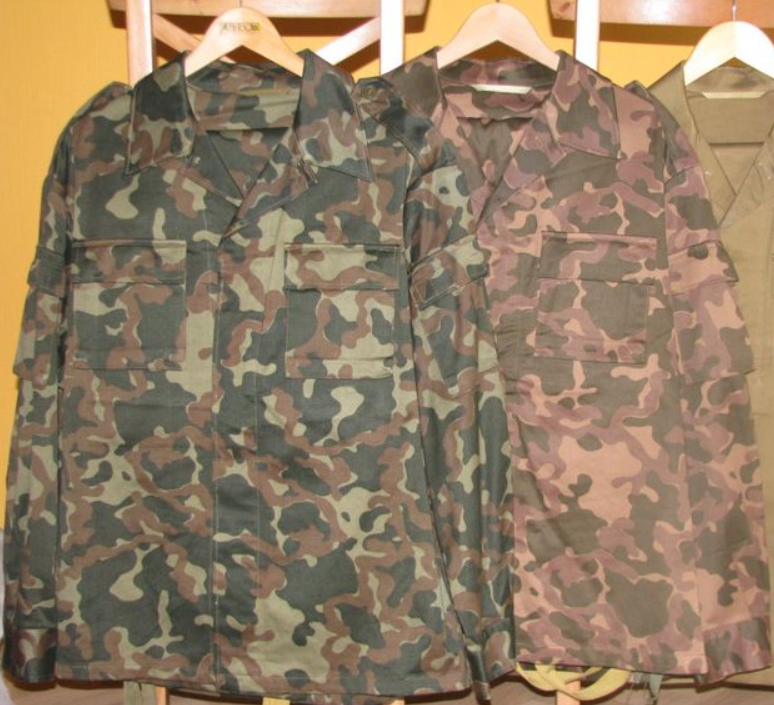
Today, soldiers of the Defense Forces of Ukraine use a huge number of different camouflage patterns, produced in Ukraine or abroad.
There are camouflages of American, German, British, Turkish, Chinese, and even Iranian production.
In this article, we will talk about the history of uniforms in the Ukrainian army. About how “Butan” was replaced by VSR-84 “Dubok”, the first pixelated digital camouflage in Ukraine, and the appearance of ММ-14.
We will consider only those patterns used in the Armed Forces of Ukraine and those that are important for understanding the evolution of camouflage.
After the collapse of the USSR, the newly created Armed Forces of Ukraine dressed in what remained of the already “deceased” Soviet army. One of these camouflages was VSR-84 (Military Forces – coloration 1984 – ed.), commonly called “Butan” or “Dubok.”
“Butan” is an unofficial name that is entrenched in the name of the camouflage project. VSR-84 was created based on the “Ozim” and “Levzeya” projects, which started in the early 1980s.
The decision to start purchasing “Butan” was made in 1984, and already in early 1985, some parts of the Soviet Airborne Forces units in Afghanistan were dressed in this uniform.
Comparing different samples of “Butan”, it can be found that, in fact, it had two patterns that, at first glance, did not detach much from each other.
For convenience in uniformology, they are divided into “Butan-A” and “Butan-B” versions. It’s interesting that two types of drawings were sewn and sent to the troops at the same time. Meanwhile, there were three “dark-color” versions that changed over time.

Most likely, this is due to the fact that sewing was carried out by various enterprises that had different technological processes.
In addition, camouflage had a rather rare variant in desert-steppe colors.
“Butan-A” met most often in the air force and marines. The Soviet Airborne Forces were equipped with two types of uniforms.
In 1990, due to the decline in production control, various shades appeared in the pattern: “Butan” was produced in pink and yellow colors.

In general, there may be much more random versions of “Butan”: in later versions, differences are noticeable not only in color but also in the pattern.
After the collapse of the USSR, “Butan” continued to be used in the armed forces of the former republics. In Russia, it was mainly used by special forces and airborne forces until it was replaced by the VSR-98 Flora.
It is known that Estonia used its own version of “Butan.”

In Ukraine, “Butan” evolved into a new version, which had a slightly modified pattern, a different cut, and a different fabric. In the Ukrainian versions, you can see how the spots “run over” each other. Further, camouflage began to be used in all branches of the troops.
In the Armed Forces, the form received several variations, one of which was the version for peacekeepers, which had a specific pinkish color.
In 1996, “Butan” evolved into the “cult” symbol of the old army – “Dubok”, which received a different pattern and cut and a greater percentage of synthetics in the fabric.

Depending on the year of sewing and manufacturer, “Dubok” can have differences in shades and drawing patterns.
One of the variations of the “Dubok” is considered to be a desert camouflage pattern, which was used by the Ukrainian peacekeeping contingent in Iraq, and later and with limitations, in Afghanistan.
This camouflage has no official name, some call it “Dubok-P” (desert), someone – “Desert,” in some places it is called D-UA (Desert-UA).
It has a similar, but still different pattern, so it is more appropriate to consider it a separate camouflage, and not a variation of “Dubok.”

All four versions of camouflage, namely “Butan-A” and “B,” its Ukrainian version, “Dubok” and desert camouflage, were used in the Armed Forces of Ukraine during the Joint Forces Operation until the introduction of new ММ-14 camouflage.

It is known that items of equipment in “Dubok” camouflage were purchased until 2014.
In 2011, the State Border Guard Service of Ukraine received a new pixel camouflage. The uniform was sewn around the old cut with minor changes.
Many believe that this camouflage was a pixelated “Dubok” or nameless camouflage, which was similar to the U.S. Woodland.
This camouflage began to be used in March 2012. Different batches had different shades, and sometimes a pixel pattern.

Further, this camouflage evolved into a darker version, which was first shown publicly during the speech of the ex-Minister of the Ministry of Internal Affairs of Ukraine, Vitaliy Zakharchenko, on February 20, 2014.
This camouflage was produced in both the old cut and the new one used in the ММ-14. But this camouflage did not go beyond the Ministry of Internal Affairs.

In 2012, camouflage was tested in the army, and was allegedly called “Pixel,” although there was not a single proof of this.
This camouflage became widespread in the 8th Army Corps, which was disbanded in March 2015. “Pixel” became the most widespread in the 30th Mechanized Brigade.
The shape cut was developed by the Norwegian company NFM Group, commissioned by the Ministry of Defense of Ukraine.

The pattern was based on SBGS` pixel camouflage with the addition of burgundy, and the pattern was increased during development.
In addition, there was information that there were plans to pixelate “Dubok”, but this idea was quickly abandoned. In general, the camouflage visually resembled the pixelated German Flecktarn and Bulgarian M18.
Interestingly, the COMBAT SpN company, which produces Predator camouflage, participated in camouflage tests. The company’s specialists harshly criticized the then-new product.
It was argued that such a drawing would work only in a dark forest, while in the steppe territories, in Crimea, or in urban conditions, camouflage was believed to be absolutely unsuitable.
The black spots in the figure were too large, which negatively affected the breakdown of the silhouette, and the spots of different colors had the same shapes.
“This whole system indicates that this camouflage was developed by non-experts in this matter. They just took part of the existing [pattern], slightly increased [it], made a copy of the black spots, and repainted them brown,” the company noted.

The company’s specialists criticized camouflage developers and the Ministry of Defense of Ukraine for rushing to create camouflage without conducting serious research and tests. The quality of the fabric and pattern was called terrible.
For example, MultiCam, according to its developers, was created and brought to modern condition in about 10 years — nearly as long as it took the U.S. Army to prepare the Scorpion W2 pattern, which became OCP camouflage.
“Compared to the camouflage used in the Armed Forces of Ukraine now, this camouflage is better. But it is not effective in the context of application in all branches,” the COMBAT SpN stated.
In large quantities, the uniform with such camouflage was not produced; later, it could be seen on the fighters of the 30th Mechanized Brigade during the Joint Forces Operation.
A new, unknown, and unnamed variation of pixel camouflage appeared in 2013. It had a different color palette and already resembled a modern ММ-14. The pattern was identical to the “Pixel” of the 2012 pattern.

Camouflage tests took place on the base of the 95th Air Assault Brigade. But after the tests, this camouflage was not spotted anywhere.
During the Perspektyva-2012 exercise, soldiers from the 95th Air Assault Brigade appeared in the Mount Trac MK-2 kit in A-TACS AU camouflage. Kits were produced by the Ukrainian company P1Gtac.
Subsequently, Mount Trac MK-2, which representatives of the army called “Gorka МК-2” did not go into the series; it was and remains popular, but only in the commercial market.

In addition, operators of the 8th Separate Special Forces Regiment in the same exercises lit up in uniforms of the same Norwegian company, NFM Group.

In 2014, the procurement of “Dubok” was stopped, and on August 21, 2014, the ММ-14 came to replace it.
For the new uniform, the cut of the same NFM Group company was used with some changes. The first variations of the MM-14 received the nicknames “Poroh-1” and “Heleteika,” in honor of the then-president and minister of defense, respectively (Petro Poroshenko and Valeriy Heletiy).

On July 15, 2015, the Ministry of Defense of Ukraine approved the list of items in the Combat Uniform Set for servicemen, which included ММ-14.
Unlike the “Pixel” model of 2012 and 2013, the new camouflage received a five-color palette practical for industrial landscapes in the Donetsk region and the steppes of the Kherson region.
The palette consists of light beige, light green, swamp green, gray green, and dark gray colors and shades.
The first batches immediately showed their main disadvantage – they were highly flammable.
In 2015, the cut of the uniform changed; it was developed by the Ukrainian company PROF1 Group. The new form received more practical innovations and began to be produced in two versions of fabric – twill and ripstop.
Compared to the old version, the shape has become more refractory, convenient, and hardy to various weather and temperature conditions. At the same time, there was a problem with fading in the sun and after washing. Although some military personnel jokingly called it a plus for the conditions of urban development.

Later, a naval version of the ММ-14 appeared in analogy with the American NWU Type 1. In addition, the SBGS updated its “wardrobe,” having received ММ-14 with impurities of a greenish color.
Підтримати нас можна через:
Приват: 5169 3351 0164 7408 PayPal - [email protected] Стати нашим патроном за лінком ⬇
Subscribe to our newsletter
or on ours Telegram
Thank you!!
You are subscribed to our newsletter